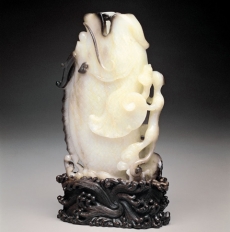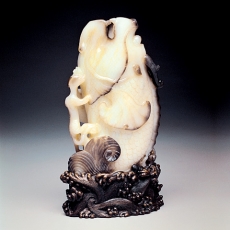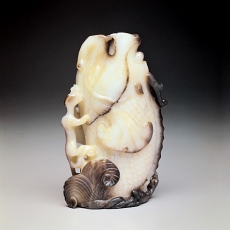TELDAP Collections
| Fish-creature Flower Holder |
|
In general, "creating auspiciousness" was a very important design consideration in the forms and decoration of Chinese antiquities, and auspicious decoration and people's desire for blessings and good fortune have always been inextricably bound. For this reason, auspiciousness as a theme in Chinese art has been particularly strong. Not only has it been handed for generation upon generation, it has also been represented in a myriad forms and manifestations. The general external appearance of this work is that of a fish, jumping up with its tail curled as the area beneath has been carved in the form of rolling waves. Combined with the wooden based carved with water patterns echoing this theme, the fish is obviously leaping out of the water with all its might. The head of the fish deserves special attention. Its eyes bulge and bears long whiskers and a prominent nose as the horns in particular indicate that it has begun transformation into a dragon. Apparently, this is a metaphor for the auspicious theme of "a fish leaping through the dragon's gate". The reference to this story can be found in "Record of Three Ch'in": "The fish of the rivers and seas gather below the dragon's gate; those who pass, turn into dragons." "Dragon's Gate" is one of the features of the terrain along the Yellow River, marked by its rushing waters. Fish that want to pass through have to struggle with all their might. The Chinese people took this natural phenomenon as a metaphor for the life of a poor scholar sitting for the imperial civil service examinations, success in which could transform a common person into an official at court. Despite the difficulties and low rate of success, such a transformation would bring untold benefits, like an ordinary fish changing into a lofty dragon.
Ming Dynasty (1368-1644), Height: 15.6 cm, greatest width: 9.55 cm National Palace Museum
|















